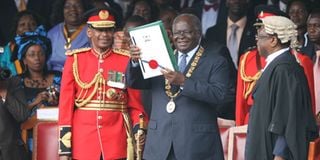Premium
History shows Constitution was produced through elite consensus

What you need to know:
- Some of the requirements cited by the High Court in the BBI case, such as civic education, left us in a quandary.
- They created a circularity of logic regarding who is to instruct or educate the more supreme power?
In the just-concluded BBI appeal, two friends of the court filed powerful written briefs. One, by Prof Migai Akech, offers a powerful rebuttal on the High Court’s reading of history.
Understanding the history is important because it provides the context and a glimpse into minds of those who framed the Constitution of Kenya 2010.
History shows the 2010 Constitution was very much an elite pact. The failure to find political compromise in the years before the 2005 referendum resulted in victory for the NO vote. The National Rainbow Coalition rode to office partly on the promise of delivering a new constitution in the first 100 days. But disagreements led to a contested referendum. The poisoned atmosphere led to the hotly contested presidential elections of 2007.
The campaigns involved intense ethnic mobilisation. The violence in the days before and after those elections led to a mediation process among the political elite.
While President Mwai Kibaki and Rt. Hon Raila Odinga were the principals, negotiating for the PNU were Martha Karua, Moses Wetang’ula, Sam Ongeri and the late Mutula Kilonzo. ODM fielded. James Orengo, William Ruto, Sally Koskei and Musalia Mudavadi. The outcome was the grand coalition government.
The Constitution of Kenya Review Act 2008 was one of the immediate deliverables of that grand coalition. This act facilitated the promulgation of a new constitution in 2010. Apart from the referendum, all the other institutions did not involve Wanjiku directly. Rather, they were a committee of experts, the parliamentary select committee and the National Assembly itself.
The committee of experts, not Wanjiku, produced the harmonised draft. The experts referred all contentious issues for political negotiations by the parliamentary select committee, chaired by Senior Counsel Abdikadir Mohamed. The issues were system of government, devolution and, transitional and consequential provisions.
By achieving political consensus – a compact if you like – the committee ensured a positive result at the referendum. Interestingly, not all the leaders agreed with the compact. William Ruto, a lead negotiator for ODM, decided to lead the NO campaign!
Institutions, including courts, electoral laws, assemblies or parliaments do not create themselves. They owe their legitimacy to the constituent power – the people.
Some of the requirements cited by the High Court in the BBI case, such as civic education, left us in a quandary. They created a circularity of logic regarding who is to instruct or educate the more supreme power? Who would have constituted the provider of civic education?
To create the 2010 law, the people acted through their elected representatives and Wanjiku’s consent was sought through the referendum!
The experts who handled civic education were not picked by Wanjiku. Neither was it an elected constituent assembly. Rather, it had been set up by the political elite through Parliament and the Executive.
What was different with the BBI? Drafting was by a secretariat of experts. The elected representatives considered and passed the proposals in both Houses and, in 44 counties assemblies.
Ndiritu Muriithi is the Governor of Laikipia County. @NdirituMuriithi





